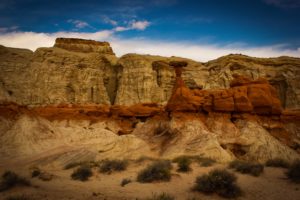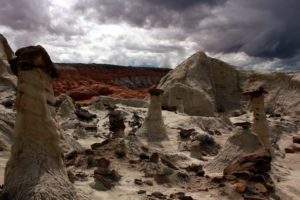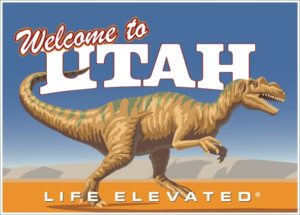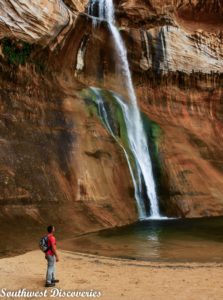 >Note: Note: This is the fourth in a series of “Hiking the Escalante” guest posts by Mitch Stevens, founder of the Tucson-based tour company Southwest Discoveries.
>Note: Note: This is the fourth in a series of “Hiking the Escalante” guest posts by Mitch Stevens, founder of the Tucson-based tour company Southwest Discoveries.
The series showcases some of the memorable adventures that await along the Escalante River Basin and its tributaries in southern Utah.
In this post, Mitch concludes the series with his visits to the Toadstools — which he describes as “a surreal and scenic experience that looks and feels as if it were taken straight from a science fiction movie” — and Calf Creek Falls, which he calls “awe-inspiring and mesmerizing.”
These hikes are well suited to adventurous, fit baby boomers with an appetite for great scenery and a side dish of geology. (Just don’t eat the Toadstools!)
By Mitch Stevens
Located along U.S. 89 in the Escalante Grand Staircase National Monument, the Toadstools trailhead leads to a series of mushroom-like formations of orange and white rocks. The route was .8 miles each way, level, and easy walking.
Geology takes front and center stage here.
A toadstool is a spire-like feature with a boulder perched atop a pedestal rock, like a mushroom, which forms when a softer rock erodes away, leaving a column sheltered from the elements.
Like a giant layer cake, the Escalante Staircase was so named thanks to the immense sequence of its sedimentary rock layers ranging from Bryce Canyon in the north to the Grand Canyon in the south.
In the 1870’s, geologist Clarence Dutton first thought of this region as a stairway with the cliff edge of each layer forming giant steps. The rocks composing the Toadstools are among the youngest layers.
Never-Before-Discovered Dinosaurs
Grand Staircase National Monument — and the area near the Toadstools in particular — are known for dinosaur fossils.
In recent years the region has yielded a bounty of fossilized discoveries, including the skull of an adult tyrannosaur and a tyrannosaur toe bone. These ancient predators are quite rare in the fossil record.
Scientists have unearthed tens of thousands of fossils from the area, especially at the Kairparowits Plateau, a 50-mile-long high elevation ridge which rises on the horizon.
During the Late Cretaceous, about 76 million years ago, the Kairparowits provided a snapshot of what life was like during the heyday of the dinosaurs. The sandstone and mudstone of the Kairparowits deposited layers of sediment that quickly buried the fossils in a pristine state.
Among the animals discovered here were 21 never-before-seen dinosaurs. These included horn-billed herbivores with a seven-foot-long skull, an oversize nose and horns which faced forward.

Paleontologists have collected more than 12,000 plant specimens from over 75 sites in the area.
Calf Creek Falls
Calf Creek Falls is a delightful 6.2-mile hike that leads to a breathtaking waterfall . The landscape rivals that of the Grand Canyon itself.
This hike has it all:
Lush green vegetation including birch trees rarely seen in a canyon — check.
A clear, bubbling stream with beaver dams and trout easily viewed — check.
Towering, desert varnish-stained Navajo Sandstone — check.
Prehistoric granaries tucked into ledges on high canyon walls — check.
Life-sized pictographs — check.
And a stunning 126-foot waterfall with a large plunge pool shaded by tall trees — check!
How to Get There
To access this hike, our group of eight intrepid explorers drove east on Utah 12 at Bryce Canyon, which led to the tiny settlement of Escalante. We continued another 15 miles to the Calf Creek Falls trailhead.
Utah 12 has been called the most scenic road in America; it was easy to see why.
While millions of people are familiar with the Grand Canyon, few realize that surrounding the canyon lies a landscape that’s equally awe-inspiring.
Grand Staircase-Escalante National Monument protects a magnificent land of deep canyons and abrupt mountains, a place where rivers continually deepen canyons and 500-million-year-old rocks are slowly eroded by the elements of the ages.
Calf Creek is a tributary of the Escalante River, the last river discovered and mapped in the lower 48 states.
Situated in the heart of the Colorado Plateau, the Escalante River flows through remote and rugged country. Even though the trailhead is off a paved road and developed campground, the trail plunges into a true wilderness of canyon, rock, and plateaus. The geologic, scenic and cultural values of this area make it one of the most special places in the Southwest.
The Route to the Falls
Characterized by horizontal sedimentary layers, the landscape here was thrust up and sliced into deep canyons. We gazed in the direction of a west facing wall; in the distance appeared to be small figures painted on the cliff face.
To get a closer look, we forded the vigorously flowing creek and walked to the base of the cliff. About ten minutes later, after a scramble up slick-rock, we stood underneath and peered up at three huge, life-sized pictographs. The spectacle was simply stunning, a dramatic example of ancient Fremont rock art at its finest.
As the canyon narrowed, sheer sandstone walls were decorated in elaborate desert varnish: a red to black coating on exposed rock surfaces in arid regions, primarily composed of oxides of iron and manganese which causes the coloration. The resulting coloration was brilliant.
Shortly afterward, the main attraction of Calf Creek Falls was visible in all its splendor.
In a region with less than 12 inches of annual precipitation, how could there possibly be so much water present?
The answer to this mystery? The sandstone in the canyons and mountains has been soaking up and storing rainfall and snowfall over the eons and it is continuously being released as seeps, springs, and hanging gardens. This stored water coming straight out of the rocks in addition to runoff from snowfall in the mountains contributes to the flowing creeks and waterfalls in the region.
While not as famous as Havasu Falls in the Grand Canyon, Calf Creek Falls is one of the most beautiful — and spellbinding — places in the entire Southwest.
For the complete text of Mitch Stevens’ blog posts, go here and here.












2 Responses to Hiking Utah: Toadstools, Dinosaurs, Waterfalls